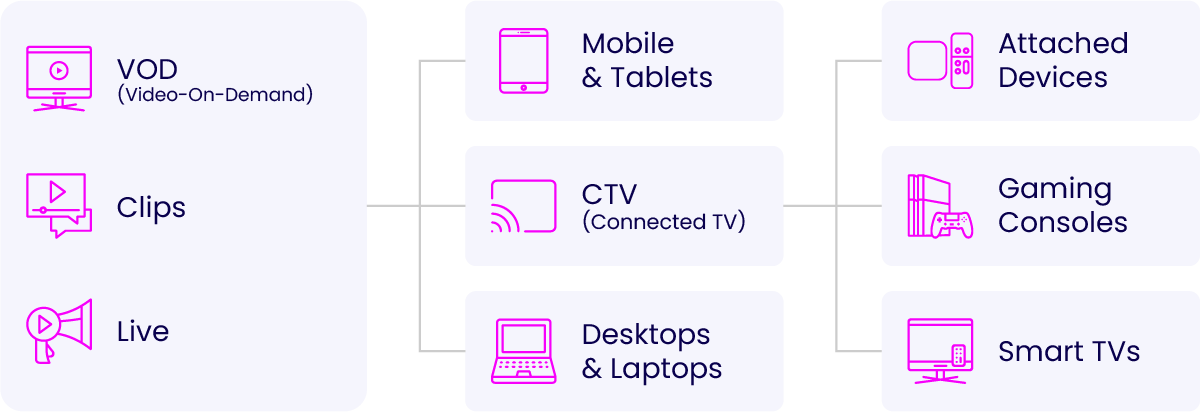There’s a lot of confusion among advertisers about OTT and CTV. Throw in more terms like OLV and it’s no wonder, as these terms are often used somewhat interchangeably, or even just thrown together, as in OTT/CTV.
It’s important for advertisers to understand the differences between the three, because while they are similar in meaning, in an advertising context, there are actually important differences. Understanding these differences can help you apply the right advertising strategy.
What is OTT?
OTT – is a delivery method. In the early days of digital video streaming, traditional linear TV content might be offered additionally as streamed over the internet, or ‘over the top of’ the internet. Companies began to appear offering strictly internet streamed content, such as familiar brands like Netflix, HULU, and Disney+ among others. These were lumped into OTT as a category. Streaming TV, as it’s also sometimes called, can be accessed over a TV, but you can also log in to these services using your laptop or a phone to consume this content.
What is CTV?
CTV – is a device, literally ‘a connected TV’ to the internet. A TV might use an internet connecting device such as an Xbox or Roku box to become ‘connected’, or it may be newish type of TV, a ‘Smart TV’, which has internet connectivity built-in along with OTT apps.
What is OLV?
OLV – is Online Video. These are the video ads that you see when you visit your favorite news or entertainment site.
Over-the-Top TV (OTT)
OTT Content Types

OTT Streaming Devices

There’s a lot of excitement in advertising circles regarding OTT and CTV advertising. And why shouldn’t there be? 80% of US households now have a CTV device.
According to eMarketer, “We estimate CTV investments in the US grew by 40.6% year over year in 2020, to more than $9 billion. Growth will accelerate this year as spending reaches $13.41 billion—a figure that will more than double by the end of our forecast period in 2025.”
According to TechCrunch, in 2021, over 6 million more households will join the ‘cord cutters’ and stop buying standard cable TV services (linear TV), bringing the total to 31.2 million households. By 2024 this is expected to grow to 46.6 million households, by comparison, today there are 77.6 million households on standard pay TV, having dropped 7.5% over the last year.
You can see part of the reason that advertising budgets are starting to move away from cable TV and towards this more advanced TV opportunity.
So as an advertiser, you need to understand this new world, and the nuances of OTT vs CTV. The basic difference between the two for advertisers is that with CTV, you’re targeting a device, while with OTT you’re targeting content.
OTT ads usually get placed much like a linear TV ad, adjacent to a piece of content that you think will attract the desired audience. Since OTT platforms require a log-in, they can relate watching behavior to a log-in address, though in most households this can be many people. OTT ads are bought through the OTT service provider, much like you buy TV advertising today.
CTV, because it’s device and not content targeted, can be purchased programmatically, like you buy display or video ads now. This gives CTV advertising a few advantages over OTT advertising.
Advantages of CTV Advertising
- CTV ads have a high degree of native brand safety.
- CTV ads can be targeted using either third party or first-party data and are bought in flexible, discrete units, vs linear TV requirements.
- CTV viewers in many cases can’t skip or fast forward through ads, so viewability can be quite high.
- Being available programmatically means that CTV media buys can have lower minimum budgets and lower costs per unit.
CTV advertising is part of the cross-channel device graph, meaning that the impact of the advertising is more measurable as consumers watch programming on one device and often will be simultaneously on another device where they might do a search driven by the ad view. This is where OLV ads can come in. Running OLV ads as part of a CTV or OTT campaign can ensure coverage across different devices as your targeted consumers are taking in their favorite content across platforms.
If you have any questions on selecting the right media strategy for your organization and are new to OTT and CTV, reach out and let’s connect!
